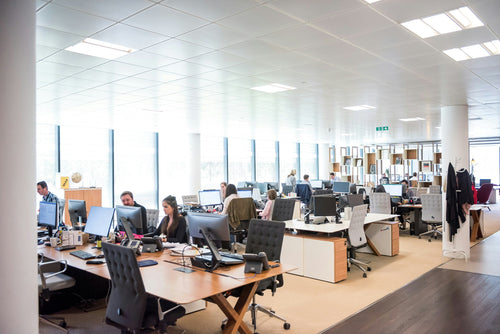
Aerosols: What are they, where are they from and where do they go?
Share
Aerosols are everywhere in today’s world; be it your morning deodorant and a spritz of hairspray, or your everyday air freshener, they can all contribute towards household air pollution.
What are aerosols anyway?
Aerosols are made up of three components: the active ingredient (which is the product itself), the propellant (which is how the product is dispensed, and is either a liquified or compressed gas), and a solvent (which is what allows the active ingredient and the propellant to mix, and then evaporates to leave the active ingredient behind).
Some history around aerosol pollution
Previously, aerosols were made using chlorofluorocarbons (CFCs) as the propellant because they’re odourless and inflammable. Their environmental impact however proved to be incredibly detrimental as they were found to be ozone depleting with high global warming potential. Global protocols shifted aerosols away from CFCs and towards volatile organic compounds (VOCs) instead. At the time, the impacts of VOCs were recognised but deemed to be less damaging than the CFC alternative. Basically, we swapped a bad option for a slightly better (but still not great) alternative.
Since this change was made, domestic aerosol use has increased significantly. Even the anticipated effects of VOCs have been much higher than originally expected. Personal care products like deodorant, body and hair spray, and antiperspirants are responsible for the largest portion of the aerosol market by both number of products and total VOC emissions. Emissions from different aerosols can vary a lot, but even small amounts of VOCs can contribute to poor indoor air quality and cause negative health effects. A study from the University of York showed that aerosol products emit more VOCs than all the vehicles in the UK, showing just how bad aerosol pollution has become.
How about some aerosol alternatives? Our Top 5 alternatives.

It can feel overwhelming to find eco-friendly alternatives to your daily aerosol personal care products, so we’ve done a round-up of some of our favourites below!
- Swap your spray deodorant for a balm or roll on. We love the Akt deodorant balm for long lasting freshness, or the Salt of the Earth roll on which comes with refill packs so you can reduce your waste while you limit aerosols!
- Switch out your Batiste for a loose powder dry shampoo between washes. I’ve been using this Corinne Taylor one for over a year and it’s great at keeping my hair fresh, and it smells delicious!
- Want your home smelling fresher? Ditch the spray air freshener and grab yourself a reed diffuser! They’re long lasting and low maintenance, making them a great option to add your favourite scent to your room.
- Spent all morning on your hairstyle just for the wind to ruin it? You don’t need tonnes of hairspray to keep it in place! Hair gel is great for those pesky flyaways, or holding extravagant looks in place. Gurl Gone Green even has a whole round-up of eco-friendly hairspray alternatives!
- It might be fun watching shaving foam expand, but you can still get that Santa Claus look using shaving soap and a brush. They also tend to last ages because you can get such a good lather!

We hope you found this round-up useful! This is an independent list that members of our team use on a regular basis, and we’re always looking for a different way of doing things. If you have any tips to add just let us know in the comments so that everyone can benefit!
If you like this blog post you can get regular monthly updates with things like this and more by signing up to our monthly newsletter here.
Further reading:
https://ghgprotocol.org/sites/default/files/ghgp/Global-Warming-Potential-Values%20%28Feb%2016%202016%29_1.pdf
https://online.ucpress.edu/elementa/article/9/1/00177/116770/Global-emissions-of-VOCs-from-compressed-aerosol
https://www.pca.state.mn.us/pollutants-and-contaminants/volatile-organic-compounds-vocs#:~:text=and%20environmental%20concerns-,Exposure%20to%20VOC%20vapors%20can%20cause%20a%20variety%20of%20health,are%20suspected%20or%20proven%20carcinogens.
https://uk-air.defra.gov.uk/assets/documents/reports/cat09/2211011000_15062022_Indoor_Air_Quality_Report_Final.pdf
https://scied.ucar.edu/learning-zone/air-quality/aerosols
Related Posts
-

How Can We Use Earth’s Resources Sustainably?
Utilising Earth’s natural resources is essential for human wellbeing and development. From building materials to ener...
-

At Home With Nature: What is Biophilic Design, and How Can I Incorporate It Into My Space?
What is biophilic design? Biophilic design is the principle of incorporating nature into the design process and style...
-

How to Improve Cognitive Function and Avoid Sick Building Syndrome
When self-reflecting and looking for self-improvement, considering your cognitive function can be a great place to st...
-

Going for Gold
Fun With Fans Back in May we had all of the fans that live within Briiv Pro arrive and apart from a fright we had wh...
-

Save Money, Live Sustainably: Practical Tips for an Eco-Conscious Lifestyle
In today’s world it feels like there are a million ways to be more ethical in our purchases, which feels like a milli...
-

Christmas Shipping 2024
Hi everyone, As we close in on the end of the year, we've listed below the advisory last posting dates for Briiv: ...
-

Briiv Fragrances; add fragrance to your home with new Briiv essential oils
Briiv 2 and Briiv 2 Pro have a built-in fragrance diffuser, so that after the harmful pollutants have been removed fr...
-

How to Get a Better Night’s Sleep
A good night of sleep is crucial to support your health and wellbeing. While a one-off late night or restless evening...
-

How to build a Briiv System
With Briiv 2 Pro you can build a mesh network of small and powerful air purifiers that work in unison to automaticall...
-

How Air Purifiers Can Help Remove Smoke and Odours During BBQ Season
As the weather continues to get warmer there’s nothing better than getting outside and cranking on the BBQ, but while...
-

How to Save Energy: Tips for Reducing Your Consumption and Bills
We all know how important it is to save energy; from cutting down on your bills to reducing fossil fuel emissions, en...
-

How To Measure Your Space for an Air Purifier
In the world of air purifiers (and trust us, it’s a pretty extensive world) it can be overwhelming to decide what’s r...
-

Behind Briiv Pro
Prototyping And Designing The Electronics We wanted to share some behind the scenes of developing the electronics tha...
-

Smelling Great
A Close Look At The New Briiv Aroma We have had a few questions about how the fragrance part works in Briiv Pro, so...
-

Pollen Protection: How Air Purifiers Can Help You Survive Allergy Season
It’s that time of year; the sun is starting to show itself, we’re creeping into Spring, and we’re stocking up on anti...
-

Briiv Pro vs. Smoke
Fun With Metal Back in December we started machining the electrodes that are going to be used to spark erode the tool...
-

How To Freshen Up Your Home
As the days are getting longer and the weather’s improving, we really are finally saying goodbye to Winter. And what ...
-

Will an Air Purifier Improve My Health?
There are plenty of reasons you’d want to bring an air purifier into your life, whether you’re wanting to remove unpl...
-

Welcome to Briiv Pro!
As it's our second time on Kickstarter, we're looking to do things a little different through this campaign and want ...
-

Christmas Shipping 2023
Hi everyone, As we close in on the end of the year, we've listed below the advisory last posting dates for Briiv: In...
-

Briiv Pro has Launched!
For a while now we've been exploring how to improve Briiv. With amazing feedback from our customers and community, al...
-

We Partnered with airQ
We recently partnered with the air quality monitor, airQ, to see how Briiv performed in a unique test environment. Br...
-

What's the deal with ozone?
With enough fear mongering online, it's understandable why you'd want to make sure your air purifier isn't actually ...
-

Caring for Briiv
Look after your Briiv so it can keep on looking after you. Your Briiv requires little to no maintenance, unlike s...
-

A Multi-Award Wining Product
Read what the experts have to say here! The idea of Briiv was born in 2019, and in the 4 years since then it's p...
-

Let's Get Social!
Whether you're into social media or not, you can benefit from learning a bit more about your favourite brands on diff...
-

Allergies? We're All-over it!
Briiv can be your shield against a season of sniffles! It's allergy season and if you're a sufferer, you know exa...
-

The Briiv Story (So Far!)
We’re all so proud here at Briiv of how far we’ve come over the past few years that we decided to take a look back at...
-

Briiv App: Trials and Tribulations
I wanted to just take some time and run through the challenges we have had and why it has taken us so long to get th...
-

Eco Excellence Awards 2022
We’re so excited to share that we recently won not one, but two Eco-Excellence Awards in the Home Air Purifier catego...
-

B Corp Certified
As of August 2022, we are incredibly proud to say that Briiv is B Corporation certified! As a B Corp business, Briiv ...
-

Solar Impulse Efficient Solution Label
The Solar Impulse foundation has collected over 1,000 clean and profitable solutions, and now Briiv is one of them. W...
-

A Year in Review
Hello everyone! As we look back on the year, any attempt to sum it all up will be an understatement to say the least....
-

Briiv Goes to the P.E.A. Awards
This past weekend, we attended the P.E.A. Awards in Marylebone, London, the UK’s leading sustainability awards. The G...
-

Embracing The Circular Economy and Designing Towards a Greener Planet: The Briiv Story So Far
Photo by Elena Mozhvilo on Unsplash The world we live in is filled with infinite wonder and incredible beauty, but ...
-

Fulfilment Plans & New Branding
Fulfilment Plans & New Branding Hello everyone! We're thrilled this month to be able to bring you news, that...
-

Production Update - June 2021
Hello everyone, It's time for our monthly update and you'll be thankful to hear the updated timelines we set ou...
-

The A' Design award
More Outstanding Recognition for briiv We are thrilled to announce we are the recipients of yet another prestigious d...
-

Red dot winner 2021
Award-Winning We're extremely excited to share the news that this last month, we won an award for the briiv Air Filte...
-

We're on track! / Carbon Neutral
Hello everyone, Production Update We hope you are all keeping safe and well. It's been a month since our last up...
-

Manufacturing Update - December
Hey everyone, We hope you are all well and want to say thank you for all your messages and support recently. We'...
-

Inside Story, Production Update
Hey everyone! It's been a great few weeks for us as we begin to put into action our production schedule! We have a fe...
-

Plants. Do they actually clean my homes air?
Hi everyone! We're fast approaching the end of our Kickstarter campaign and we've really enjoyed your feedback and an...











































